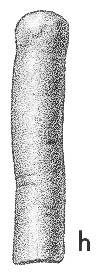
Revised descriptions of New Zealand Cenozoic Mollusca from Beu and Maxwell (1990)

 | Revised descriptions of New Zealand Cenozoic Mollusca from Beu and Maxwell (1990) | 
|
  (Pl. 11h): GS179, I41/f7445, "Maerewhenua Limestone, Waitaki Valley", probably from Kokoamu Greensand near Duntroon, Duntroonian (GNS) |
Beu & Maxwell (1990): Chapter 10; p. 152; pl. 11 h.
Classification: Teredinidae
Description: Featureless thin-shelled tubes of roughly circular or elliptical section and of irregular shape with one end (if preserved) closed by a convex septum are not uncommon in Cenozoic sediments. They may occur singly or, more commonly, in clumps, sometimes in pieces of wood, and are the tubes of wood-boring, or perhaps of softsediment- burrowing, bivalves of the family Teredinidae. (Thicker-shelled tubes of similar or larger dimensions but lacking a septum are probably of the polychaete genus Protula). Although the names Teredo heaphyi and T. directa have been proposed for similar tubes, they are taxonomically worthless, for in neither case were the type specimens reported to be associated with the pallets, the only preservable feature of use in classification. Isolated valves of teredinids occasionally turn up in washings of fossiliferous sediments, but these too "are almost useless in classification as they are extremely variable, depending on the age of the specimen and the ecologic conditions affecting it" (Turner in Moore 1969, p. N723). Only one fossil New Zealand teredinid has been based on both the valves and the pallets, Bankia turneri (Otaian, Waiheke Island), although it was not until 1978 that the latter were illustrated and the generic assignment confirmed (McKoy 1978, p. 352-353, fig. 1D). Since so little is known about the fossil history of the family, teredinid tubes should be carefully examined to see if they still retain the pallets.
Comparison: Warren and Speden (1977, p. 42) maintained that because of the absence of associated valves or wood, the tubes in the "upper Teredo limestone" are not those of teredinids but probably of some other bivalve group, possibly Clavagellidae. However, the tubes have the characters of teredinid tubes (i.e. thin shell and terminal septum) and are quite unlike those of typical clavagellids, a group with a very sparse record in New Zealand (see Pl. 19f). The absence of valves and pallets and of wood could result from diagenesis, or alternatively the tubes may be those of a sediment-burrowing member of the Teredinidae (i.e. related to the genus Kuphus). Kuphus itself has a much larger tube (c. 50 mm wide and up to nearly 1 m long), but other sediment-burrowing taxa are now known in Teredinidae.
Distribution: Teredinid tubes may be locally very common, e.g. in the "upper Teredo Limestone" (Waipawan) at Haumuri Bluff, southern Marlborough (Warren and Speden 1977, fig. 22).
Cite this publication as: "A.G. Beu and J.I. Raine (2009). Revised
descriptions of New Zealand Cenozoic Mollusca from Beu and Maxwell (1990). GNS
Science miscellaneous series no. 27."
© GNS Science, 2009
ISBN
978-0-478-19705-1
ISSN 1177-2441
(Included with a PDF facsimile file
copy of New Zealand Geological Survey Paleontological Bulletin 58 in CD version
from: Publications Officer, GNS Science, P.O. Box 30368 Lower Hutt, New
Zealand)